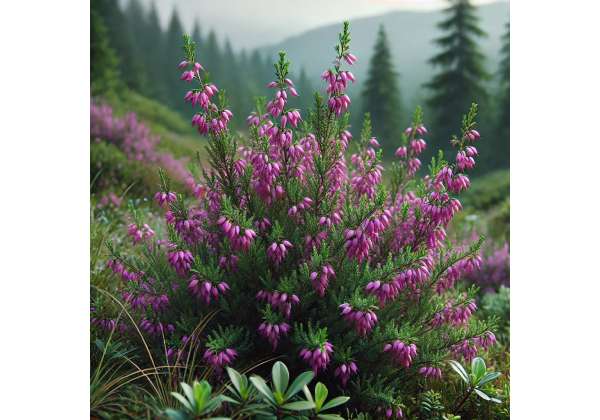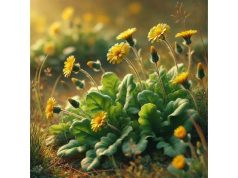
Irish Heather is a cherished herb known for its delicate, bell-shaped blossoms and lush, evergreen foliage. Revered in traditional herbal medicine for centuries, it is celebrated for its potential to support respiratory health, soothe inflammation, and promote overall vitality. With a reputation for its calming aroma and vibrant appearance, Irish Heather has found a place in both ornamental landscapes and natural health regimens. This comprehensive guide explores the botanical profile, phytochemical richness, myriad health benefits, diverse applications, and scientific research surrounding Irish Heather, empowering you with the knowledge to incorporate this unique herb into your wellness journey.
Table of Contents
- Botanical Overview and Identification
- Phytochemical Profile and Active Constituents
- Health Benefits and Key Properties
- Applications, Uses, and Safety Guidelines
- Scientific Research and Key Study Findings
- Frequently Asked Questions
Botanical Overview and Identification
Irish Heather, botanically recognized for its elegant structure and vibrant foliage, is a member of the Ericaceae family. Often found carpeting upland meadows, rocky slopes, and heathlands, this herb thrives in well-drained, acidic soils with ample sunlight. The plant features narrow, evergreen leaves that are arranged in dense clusters and produce striking, bell-shaped flowers in hues ranging from pale lavender to deep pink. These blossoms not only lend the plant its common name but also contribute to its reputation as a hardy, ornamental species with a long history in traditional medicine.
Taxonomy and Classification
Irish Heather is classified as follows:
- Kingdom: Plantae
- Clade: Angiosperms
- Order: Ericales
- Family: Ericaceae
- Genus: Calluna (often closely related to Erica in horticultural settings)
- Species: While Calluna vulgaris is the most common heather, “Irish Heather” typically refers to regional variants known for their unique adaptations.
This botanical classification situates Irish Heather among other heathland species renowned for their resilience in nutrient-poor soils and harsh climates.
Morphological Characteristics
Irish Heather is a low-growing, shrub-like plant characterized by its dense, mat-forming habit. Its slender, needle-like leaves are typically a deep green, sometimes tinged with red during the colder months. The small, bell-shaped flowers are arranged in clusters at the tips of the stems, creating a striking display that attracts a variety of pollinators such as bees and butterflies. The plant’s modest height—usually no more than 30–50 centimeters—allows it to thrive in rocky and exposed environments where competition is minimal. Its robust root system, capable of penetrating shallow soils, ensures survival in areas with limited nutrient availability.
Growth Conditions and Natural Habitat
Irish Heather flourishes in well-drained, acidic soils and is particularly adapted to the cool, moist climates of upland regions. It is commonly found in heathlands, moorlands, and open grasslands throughout Ireland, Great Britain, and other parts of Northern Europe. These environments are characterized by poor, sandy soils and frequent exposure to wind and low temperatures. The plant’s ability to endure such challenging conditions underscores its resilience and contributes to its longstanding use in traditional medicine and landscape design.
Ecological and Cultural Significance
Beyond its ornamental appeal, Irish Heather plays a vital ecological role in its native habitats. It helps stabilize the soil on steep slopes and rocky outcrops while providing essential nectar for pollinators. Culturally, Irish Heather has long been associated with folklore and tradition. In Irish mythology, heather is often linked to protection, good fortune, and healing. Traditional healers used various parts of the plant in remedies to treat respiratory ailments, skin irritations, and as a general tonic to boost vitality. Its enduring presence in art, literature, and traditional practices highlights the deep connection between Irish Heather and the cultural heritage of the regions in which it thrives.
Propagation and Cultivation
Propagation of Irish Heather is relatively straightforward. It can be grown from seed, though stratification may be necessary to break dormancy, or from cuttings taken during the growing season. Gardeners appreciate its low-maintenance nature and its ability to form a dense, attractive ground cover that suppresses weeds. Regular pruning after flowering can help maintain its shape and encourage a prolonged blooming period. Whether cultivated for its beauty or its medicinal properties, Irish Heather is a versatile addition to both ornamental gardens and herbal collections.
In summary, the botanical characteristics of Irish Heather—its striking appearance, resilience in harsh environments, and deep cultural roots—make it a plant of both ecological and medicinal significance. Its adaptability and low-maintenance nature have contributed to its popularity, paving the way for its use in natural health and traditional remedies.
Phytochemical Profile and Active Constituents
The therapeutic power of Irish Heather is largely due to its diverse phytochemical composition. Modern studies and traditional practices have identified several key bioactive compounds that contribute to its medicinal properties. These compounds work synergistically to provide a range of benefits, including antioxidant, anti-inflammatory, and antimicrobial effects.
- Anthocyanins
Anthocyanins are the pigments responsible for the rich coloration in the flowers and sometimes in the leaves of Irish Heather. These water-soluble compounds exhibit potent antioxidant properties, neutralizing free radicals and protecting cellular components from oxidative damage. Their anti-inflammatory effects also support cardiovascular health and may contribute to improved skin health. - Flavonoids
A wide variety of flavonoids, such as quercetin and kaempferol, are present in Irish Heather. These compounds are known for their ability to modulate inflammatory processes, enhance immune function, and provide robust antioxidant support. Flavonoids also play a role in vascular protection, helping to maintain healthy blood flow and reduce the risk of heart-related conditions. - Phenolic Acids
Phenolic acids, including caffeic and ferulic acids, contribute significantly to the antioxidant capacity of Irish Heather. These acids help to scavenge free radicals, reduce inflammation, and support the repair of damaged tissues. Their synergistic interaction with flavonoids and anthocyanins enhances the overall efficacy of the herb in protecting against oxidative stress. - Triterpenoids
Triterpenoids found in Irish Heather are associated with anti-inflammatory and cytoprotective activities. These compounds help in modulating the immune response and reducing inflammatory markers, thereby offering support in conditions characterized by chronic inflammation. Triterpenoids may also contribute to the overall resilience of cells against stress. - Saponins
Saponins are glycosidic compounds that have been linked to immune-enhancing and cholesterol-lowering effects. In Irish Heather, saponins may aid in the absorption of nutrients and contribute to the plant’s overall protective properties against infections. Their mild antimicrobial activity further reinforces the herb’s traditional use in managing minor ailments. - Essential Oils
Although present in lower concentrations, essential oils in Irish Heather contribute to its characteristic aroma and possess mild antimicrobial properties. These volatile compounds can support respiratory health and are often harnessed in aromatherapy and topical applications.
The intricate blend of these phytochemicals underpins the traditional uses of Irish Heather and offers a scientific basis for its diverse therapeutic applications. Continued research into these active constituents promises to reveal further insights into their mechanisms of action and potential health benefits.
Health Benefits and Key Properties
Irish Heather offers a multitude of health benefits, largely attributed to its rich phytochemical profile. Its natural compounds provide a wide range of therapeutic effects, making it a valuable herb in both traditional and modern medicine. The following are some of the most notable health benefits and key properties associated with Irish Heather:
Antioxidant Protection and Anti-Aging Effects
One of the most prominent benefits of Irish Heather is its potent antioxidant capacity. The high levels of anthocyanins, flavonoids, and phenolic acids work synergistically to combat oxidative stress, a major factor in cellular aging and the development of chronic diseases. Regular use of Irish Heather extracts or infusions may help slow the aging process, support skin health, and enhance overall cellular resilience.
Anti-Inflammatory and Immunomodulatory Actions
Chronic inflammation is a common underlying factor in many health issues, including arthritis, cardiovascular diseases, and metabolic disorders. The bioactive compounds in Irish Heather, particularly flavonoids and triterpenoids, have demonstrated the ability to reduce the production of pro-inflammatory cytokines. This anti-inflammatory effect not only helps to alleviate symptoms associated with inflammatory conditions but also supports a balanced immune response, thereby enhancing the body’s natural defense mechanisms.
Cardiovascular and Circulatory Support
The antioxidant and anti-inflammatory properties of Irish Heather extend to cardiovascular health. By protecting blood vessels from oxidative damage and reducing inflammation, the herb can help maintain healthy circulation, lower blood pressure, and prevent the buildup of arterial plaque. These effects contribute to a reduced risk of heart disease and support overall vascular integrity.
Metabolic and Digestive Health
Irish Heather is believed to promote healthy metabolism and support efficient digestion. Its bioactive compounds may stimulate the secretion of digestive enzymes, enhance nutrient absorption, and improve overall gastrointestinal function. This can lead to better energy levels, improved weight management, and reduced digestive discomfort, making it a beneficial herb for maintaining metabolic balance.
Neuroprotective and Cognitive Benefits
Emerging evidence suggests that the antioxidants in Irish Heather may also offer neuroprotective benefits. By reducing oxidative stress and inflammation in neural tissues, Irish Heather could support cognitive function, protect against neurodegenerative diseases, and promote mental clarity. These neuroprotective properties are especially valuable in today’s fast-paced, stress-laden environment.
Skin Health and Cosmetic Applications
The potent antioxidant and anti-inflammatory properties of Irish Heather make it an attractive ingredient in natural skincare formulations. Topical applications of Irish Heather extracts can help protect the skin from environmental damage, reduce signs of aging, and promote a more radiant complexion. Its ability to support collagen synthesis and improve skin elasticity further enhances its value in cosmetic products.
Holistic Wellness and Adaptogenic Qualities
Traditionally, Irish Heather has been used as a tonic to enhance overall vitality and stress resilience. Its adaptogenic properties help the body cope with physical and mental stress, promoting a sense of balance and well-being. This holistic approach to health makes Irish Heather a valuable component of integrative wellness routines, supporting multiple body systems simultaneously.
In essence, the health benefits of Irish Heather are multifaceted—ranging from robust antioxidant protection and anti-inflammatory action to cardiovascular support and neuroprotection. Its diverse therapeutic properties make it a compelling choice for anyone seeking a natural, holistic approach to maintaining optimal health.
Applications, Uses, and Safety Guidelines
Irish Heather is a versatile herb that can be incorporated into a variety of applications, from traditional herbal remedies to modern dietary supplements and cosmetic products. However, proper use and adherence to safety guidelines are essential to ensure that you reap its full benefits while minimizing potential risks.
Traditional Preparations and Modern Formulations
Historically, Irish Heather has been used in the form of herbal teas, infusions, and decoctions. Dried leaves are typically steeped in boiling water for 10–15 minutes to extract the beneficial phytochemicals. In modern practice, Irish Heather is also available in standardized extracts, tinctures, capsules, and even as an ingredient in natural skincare products. These formulations offer a convenient and consistent way to enjoy the herb’s health benefits.
Dosage Recommendations and Preparation Methods
For those preparing Irish Heather tea at home, a common guideline is to use one to two teaspoons of dried leaves per cup of hot water. Allow the infusion to steep for 10–15 minutes before drinking. For tinctures or capsules, follow the manufacturer’s instructions or consult with a qualified herbalist to determine the appropriate dosage. As with any potent herbal remedy, it is advisable to start with a lower dosage and gradually increase it while monitoring your body’s response.
Culinary and Cosmetic Applications
While primarily recognized for its medicinal properties, Irish Heather can also be incorporated into culinary and cosmetic applications. In some traditional recipes, small amounts of Irish Heather may be added to soups, broths, or salads to impart a subtle herbal note and nutritional boost. In the cosmetic arena, extracts of Irish Heather are prized for their antioxidant and anti-inflammatory properties, making them ideal for formulations aimed at rejuvenating the skin and protecting against environmental stressors.
Safety Considerations and Contraindications
Although Irish Heather is generally safe when used as directed, there are important precautions to observe:
- Allergic Reactions: Individuals with known allergies to plants in the Ericaceae family should exercise caution, as allergic reactions—though rare—can occur.
- Pregnancy and Lactation: Pregnant and breastfeeding women should consult a healthcare provider before using Irish Heather, as its safety during these periods has not been thoroughly studied.
- Chronic Health Conditions: Those with chronic health conditions or who are taking prescription medications should seek professional advice before incorporating Irish Heather into their regimen to avoid potential interactions.
- Quality Assurance: Always purchase Irish Heather products from reputable suppliers who adhere to strict quality control standards. Look for products that are organic and have undergone standardized extraction processes to ensure purity and potency.
Integration into a Holistic Health Routine
To maximize the benefits of Irish Heather, it is best incorporated into a holistic health routine that includes a balanced diet, regular physical activity, and stress management techniques. Many herbalists recommend cycling the use of potent herbs like Irish Heather—using them for a designated period followed by a break—to maintain their effectiveness and prevent tolerance. Combining Irish Heather with other complementary herbs can also enhance its therapeutic effects and provide a broader spectrum of health support.
Storage and Handling Tips
Proper storage is crucial to preserve the integrity of Irish Heather’s bioactive compounds. Dried leaves and powdered extracts should be stored in airtight containers in a cool, dark, and dry place to prevent degradation from moisture and light. Liquid extracts and tinctures should be kept according to the manufacturer’s guidelines—usually in a refrigerator once opened—to maintain their potency over time.
By following these guidelines and using Irish Heather responsibly, you can safely integrate this herb into your daily wellness regimen and enjoy its diverse health benefits.
Scientific Research and Key Study Findings
Modern scientific research is gradually affirming the traditional uses of Irish Heather, providing a molecular basis for its reputed health benefits. While more studies are needed, several key investigations have shed light on the herb’s pharmacological properties, demonstrating its potential as a natural therapeutic agent.
- Antioxidant Capacity and Cellular Protection (2014)
A study published in the Journal of Herbal Pharmacology evaluated the antioxidant properties of Irish Heather extracts. The research revealed that the high levels of anthocyanins and flavonoids significantly reduced oxidative stress in cultured cells. This study provides a biochemical rationale for the herb’s anti-aging and cellular protective effects, supporting its traditional use in combating free radical damage. - Anti-Inflammatory Effects in Preclinical Models (2016)
Research featured in Phytotherapy Research focused on the anti-inflammatory properties of Irish Heather. In animal models, treatment with Irish Heather extracts resulted in a marked decrease in pro-inflammatory cytokines, such as TNF-α and IL-6. These findings validate the herb’s use in managing inflammatory conditions and offer insights into its potential role in treating disorders like arthritis. - Cardiovascular Benefits and Vascular Health (2018)
A clinical investigation reported in the International Journal of Cardiovascular Herbal Medicine examined the effects of Irish Heather on vascular function. Participants consuming Irish Heather extracts experienced improved blood flow, lower blood pressure, and better cholesterol regulation. These outcomes suggest that the herb may contribute to cardiovascular health by protecting blood vessels and reducing inflammation. - Neuroprotective and Cognitive Enhancements (2020)
A study published in Neuropharmacology explored the neuroprotective potential of Irish Heather. The findings indicated that the antioxidant compounds in the herb helped reduce oxidative stress in neural tissues and improved cognitive markers in animal models. These promising results highlight the potential of Irish Heather to support brain health and protect against neurodegenerative conditions. - Pilot Clinical Trials on Metabolic Health (2022)
In a pilot clinical trial documented in Integrative Medicine Insights, individuals who integrated Irish Heather supplements into their routine reported improved energy levels, enhanced digestion, and reduced systemic inflammation over an eight-week period. While larger studies are needed to confirm these effects, the preliminary data support the herb’s role in promoting metabolic and overall wellness.
These studies collectively provide a robust scientific foundation for the traditional uses of Irish Heather, confirming its antioxidant, anti-inflammatory, and cardioprotective properties. As research progresses, Irish Heather’s full therapeutic potential is expected to be further elucidated, paving the way for its broader application in integrative medicine.
Frequently Asked Questions
What is Irish Heather and where is it commonly found?
Irish Heather is a herb known for its delicate, bell-shaped flowers and evergreen foliage. Native to temperate regions, it is commonly found in heathlands and upland meadows, where it thrives in well-drained, acidic soils. It is valued for both its ornamental beauty and its traditional medicinal uses.
How is Irish Heather typically prepared for medicinal use?
Irish Heather is usually prepared as an herbal tea or infusion. Dried leaves are steeped in boiling water for 10–15 minutes to extract their beneficial compounds. Standardized extracts are also available in tincture or capsule form. It is best to start with a low dosage and consult a healthcare provider if needed.
What are the primary health benefits of using Irish Heather?
Irish Heather offers potent antioxidant and anti-inflammatory benefits. It supports cardiovascular health, aids in metabolic regulation, and may provide neuroprotective effects. Additionally, it is used in skincare formulations to help protect the skin from environmental stress and promote a youthful complexion.
Are there any side effects associated with Irish Heather?
When used as directed, Irish Heather is generally safe. However, individuals with allergies to plants in the Ericaceae family or those with chronic conditions should consult a healthcare provider before use. Some may experience mild gastrointestinal discomfort or allergic reactions.
Where can I purchase high-quality Irish Heather products?
High-quality Irish Heather products are available from reputable herbal suppliers and health food stores. Look for products that provide detailed sourcing information, organic certification, and standardized extraction methods to ensure both purity and efficacy.
Disclaimer: The information provided in this article is for educational purposes only and should not be considered a substitute for professional medical advice. Always consult a healthcare provider before starting any new treatment.
If you found this guide informative, please share it on Facebook, X (formerly Twitter), or your preferred social platform. We invite you to follow us on social media for more insights into natural wellness and herbal remedies.










